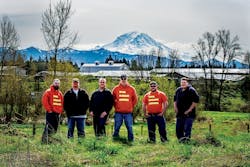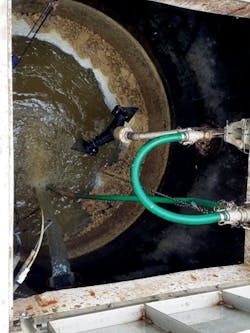About the author: Lauren Baltas is assistant editor for W&WD. Baltas can be reached at [email protected] or 847.391.1019.
Wastewater treatment is a dirty job, but with dirt comes cleaning.
Wastewater treatment professionals spend valuable time cleaning various system components. Ask nearly any municipal wastewater crew member and they will tell you that one of the most time-consuming cleaning challenges is FOG—fats, oils and grease.
FOG primarily is a product of kitchens. When foods are prepared, the residual fats, oils and grease washed off kitchen utensils, floors and other surfaces are sent down the drain. Eventually, this soapy dishwater cools down and the FOG separates from the water, accumulating in drains, sewers and lift stations. The final accumulation forms a thick mat in the lift station, which can break parts and disrupt treatment processes. In order to avoid these costly interruptions, treatment crews must spend hours—up to several times a month—cleaning the lift stations.
FOG Elimination
Certain technologies, such as Anue Water Technologies’ EP Systems, take the responsibility of cleaning out of the crew members’ hands. The system recycles discharged wastewater, automating lift station cleaning without chemicals and making it cost-effective and sustainable.
The system is a multi-step process. Surface agitation breaks buildup, adding oxygen to the recycled wastewater. This process homogenizes solids, eliminating FOG and biofilm in the process.
In the lift station, this system turns on four or five times per hour, keeping the water moving and preventing FOG from collecting into disruptive mats. The system runs for a few minutes whenever the pump turns on or when the municipality sets the timer, for example, during high flow hours such as early morning.
Certain lift stations in the city of Carlsbad, Calif., use multiple FOG removal units.
In Action
Every three months, the city of Carlsbad, Calif., sent two to three crew members to wet wells in 12 lift stations for regular cleaning. This maintenance required a lot of time and energy, so the municipality sought a solution.
Anue Water Technologies approached Jesse Castaneda, city of Carlsbad wastewater supervisor, with its EP System, but it had to pass Castaneda’s 5-gal bucket test.
“My thing is, let’s get a 5-gal bucket with grease in it, put the [technology] in there, and if it works in a 5-gal bucket, I might be willing to try it at a lift station,” Castaneda said.
The system passed the test. The municipality tried its first EP System eight years ago and now has a total of eight units at six of its lift stations, with more expected in the future. Its lift stations range from 30,000 to 1.2 million gal per day, meaning that some stations have multiple units installed while others only require one.
Now these lift stations only need to be cleaned every six months—a significant decrease in man-hours dedicated to the task, which is exactly what Castaneda appreciates. With FOG taken care of, the only issue Castaneda and his crew deal with is “flushable” wipes.
“If it wasn’t for [the flushable wipes] we could go probably nine months or longer—a year or two—to clean the wet wells,” he said. “They just float on top, so we still have to clean them.”
Carlsbad residents also appreciate the new technology, whether they know of it or not. The city serves approximately 103,000 residents and has a thriving tourism industry. In the California heat, when a lift station breaks down from the stress of FOG, it creates a strong odor. The stations are in neighborhoods and near the downtown area, so when there is an odor, Castaneda receives a call about it.
“When we get a call from a citizen, we have to respond within an hour, and even if it’s early in the morning, late in the day, a weekend or a holiday, we have to respond,” he said.
A Municipality Standard
A growing area serving approximately 20,000 residents, the city of Bonney Lake, Wash., also faced issues with FOG in its lift stations. The city has 25 lift stations in its system, some processing 600,000 gal of sewage a day. After frequently dealing with FOG in these stations, the municipality required a change.
In the past, three Bonney Lake crew members spent a full day every two weeks (not to mention unexpected false alarms after hours) removing two to three loads of debris, including FOG, from the station—a loss of time and resources.
Since then, the city has installed EP Systems at eight of its lift stations and has budgeted to install two to three every year moving forward. The technology has become a mainstay, as the municipality has written it into its specifications and standards. Now, crewmembers need only clean the stations every six months.
“We were sending three guys down there, so that’s costing me 18 hours of man-hours twice a month,” said Curt Roundtree, Bonney Lake sewer department lead. “This gives me the opportunity to send them off on other tasks instead of doing that. It also saved us on our overtime being called out for health alarms or clogged pumps. It has saved us hours upon hours so we can go do something else.”
The residents of Bonney Lake appreciate the new technology, as well. Because many of the lift stations are near housing developments, a decrease in FOG equates a decrease in odor. Roundtree no longer receives odor complaints.
“Having the peace of mind that calls won’t be coming from one of our stations—I feel good about that,” he said.
The system breaks buildup and adds oxygen to the recycled wastewater.


